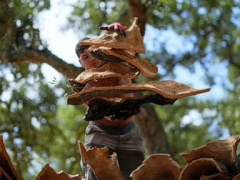RIO FRIO, Portugal — U.S. winemakers have something to celebrate: the corks they’re popping aren’t subject to tariffs.
Cork comes from the spongy bark of the cork oak tree, which is primarily grown and harvested in the Mediterranean basin. The framework trade agreement between the United States and the European Union singled out the material as an “unavailable natural product.” So as of Sept. 1, cork joined a handful of other items, including airplanes and generic pharmaceuticals, that are exempt from a 15% U.S. tariff on most EU products.
The cork carve-out was vital for Portugal. The European country is the world’s largest cork producer, accounting for about half of global production.
Portuguese diplomats lobbied for the exemption on both sides of the Atlantic. Patrick Spencer, the executive director of the U.S.-based Natural Cork Council, raced from Salem, Oregon, to Washington in June to explain cork’s origins to U.S. trade officials and to seek a tariff reprieve. The Wine Institute, which represents California vintners, said it also pushed for the special dispensation.
Spencer said he was thrilled when a summary of the U.S.-EU agreement released in August mentioned cork.
“It was a great day in our neighborhood,” said Spencer, a self-described “cork dork.”
It’s unclear if cork is unique or if other natural products will be exempt from U.S. tariffs in future trade agreements. The U.S. Department of Commerce and the White House did not respond when The Associated Press asked about tariff exemptions.
It’s not even clear if the tariffs President Donald Trump put on imports from the EU’s 27 member nations and almost every country will remain. Late last month, a U.S. appeals court ruled that Trump had no right to impose his sweeping tariffs, although it left them in place while his administration appeals to the U.S. Supreme Court.
But if the tariffs stay in place, cork may signal other exemptions to come. U.S. Commerce Secretary Howard Lutnick indicated during a July interview with CNBC that natural products like mangoes or cocoa may be free from tariffs
The U.S. is the second-largest market for Portuguese cork after France. In 2023, the U.S. imported $241 million worth of cork from Portugal; just over 70% of it came in the form of stoppers for wine, spirits, olive oil, honey and other liquids, according to the Natural Cork Council, a trade group.
Cork has other applications, too. NASA and SpaceX have used it for thermal protection on rockets. Cork crumbles are also used as infill for sports fields and inserted into concrete on airport runways to help absorb the shock of plane landings.
Even though California has a similar climate to the Mediterranean, the U.S. has never developed a cork industry. There was an attempt to start one during World War II, and around 500 cork oaks from that period remain on the campus of the University of California, Davis.
But the effort evaporated when the war ended. The problem: it takes 25 years for a cork tree to produce its first bark for harvesting, and the initial yield typically isn’t high quality. After that, i




